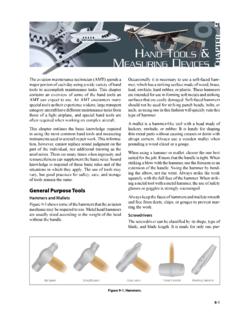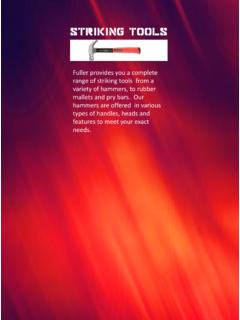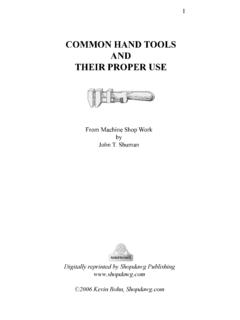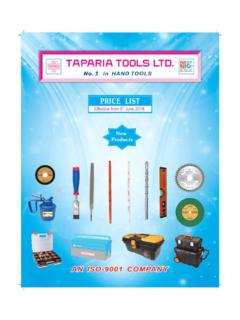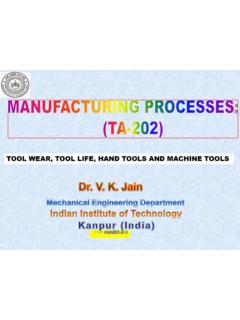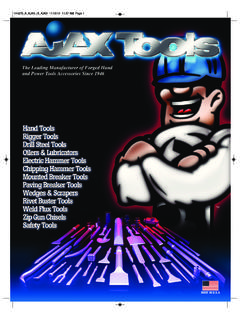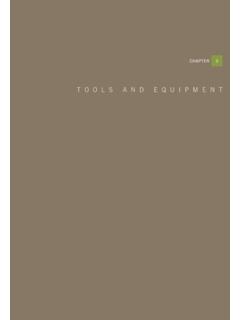Transcription of A Guide to Selecting Non-Powered Hand Tools
1 Easy Ergonomics:A Guide toSelectingNon-PoweredHand ToolsDepartment of Industrial RelationsCal/OSHA Consultation ServiceResearch and Education UnitDEPARTMENT OF HEALTH AND HUMAN SERVICESC enters for Disease Control and PreventionNational Institute for Occupatonal Safety and HealthThis booklet is a joint effort betweenthe California Occupational Safety and Health Administration (Cal/OSHA)and the National Institute for Occupational Safety and Health (NIOSH),Centers for Disease Control and Prevention (CDC).DisclaimerMention of any company name or product does not constituteendorsement by Cal/OSHA or document is in the public domain and may be freely copied or information about occupational safety and health topics contact NIOSH at:1-800-35-NIOSH (1-800-356-4674)Fax: 513-533-8573E-mail: Institute for Occupational Safety and HealthPublications Dissemination4676 Columbia ParkwayCincinnati, OH 45226-1998 Download this publication from Cal/OSHA or NIOSH: Ergonomics.
2 A Guide to Selecting Non-Powered Hand Tools was developed and preparedfor publication by the Research & Education Unit, Cal/OSHA Consultation Service, CaliforniaDepartment of Industrial Relations and the National Institute for Occupational Safety and was distributed under the provisions of the Library Distribution Act and Government CodeSection by the California Department of Industrial Relations and theNational Institute for Occupational Safety and Health, (NIOSH) Publication No. 2004-164 Easy Ergonomics:A Guideto SelectingNon-PoweredHand ToolsAbout This BookletThe purpose of this booklet is to help you select or purchase the best available ergonomicallydesigned Non-Powered hand tool .
3 The information and the hand tool checklist are based on peer-reviewed articles and expert input. The checklist has been evaluated for reliability in identifyingthe presence or absence of basic ergonomic design features (Dababneh et al.*). The right toolwill help you reduce your risk of injury, such as carpal tunnel syndrome, tendonitis, or musclestrain.*Dababneh A, Lowe B, Krieg E, Kong Y, and Waters T, A Checklist for the ErgonomicEvaluation of Non-Powered Hand Tools , accepted for publication in the December 2004 issue ofthe Journal of Occupational and Environmental : This booklet covers most ergonomic features that should be considered when Selecting orpurchasing hand Tools , but does not cover all features.
4 Specifically, it does not address toolweight, tool balance, vibration or tool one is required to use the information in this booklet. This booklet is not intended toprovide employers with information on how to comply with Cal/OSHA Howard, , NIOSHLen Welsh, , Chief, Cal/OSHANon- powered hand Tools are widely used in a variety of industries including construction,manufacturing, and agriculture. National data suggests that a large number of injuries known asmusculoskeletal disorders are attributable to hand tool use in occupational settings, resulting inunnecessary suffering, lost workdays, and economic costs.
5 Prevention of work-relatedmusculoskeletal disorders is a high priority for both the National Institute for Occupational Safetyand Health (NIOSH) and the California Occupational Safety and Health Administration (Cal/OSHA).Both agencies recognize the importance of design and selection of hand Tools in strategies to reduceinjuries of this the untrained eye, however, it may be difficult to evaluate Tools from an ergonomic point of purpose of this document is to demystify the process and help employers and workers identifynon- powered hand Tools that are less likely to cause injury--those that can be used effectively withless force, less repeated movement, and less awkward positioning of the body.
6 Presented here arethe ergonomic basics of hand tool use. These principles are meant to complement the ordinaryprocess of deciding on what tool to select by knowing how it is used and the task to which it will reasonable and common-sense approaches outlined in this document can be directly applied tochallenges like these: deciding whether to stay with traditional tool designs or opt for new designs evaluating the effectiveness of different designs choosing a tool of the right size and shape for the task and the userThis document also contains an easy-to-use checklist for comparing Tools against several designcharacteristics that have been shown to reduce physical stresses on the user.
7 We hope this checklistand the accompanying background material will be of practical use to all who wish to select toolsthat get the job done more safely, comfortably, and this anhand tool ?ergonomicYou be the judge ..Some Tools are advertised as ergonomic or are designed with ergonomic features. A toolbecomes ergonomic only when it fits the task you are performing, and it fits your hand withoutcausing awkward postures, harmful contact pressures, or other safety and health risks. If you usea tool that does not fit your hand or use the tool in a way it was not intended, you might developan injury, such as carpal tunnel syndrome, tendonitis, or muscle strain.
8 These injuries do nothappen because of a single event, such as a fall. Instead, they result from repetitive movementsthat are performed over time or for a long period of time, which may result in damage to muscles,tendons, nerves, ligaments, joints, cartilage, spinal discs, or blood PosturesPostures that strain the neck,shoulders, elbows, wrists, hands , or back. Bending,stooping, twisting, andreaching, are examples ofawkward PressurePressure from a hard surface, point, oredge on any part of the ToolsTube-like Tools measured by handle lengthand length of astraight linethrough the centerof the GripThe hand grip thatprovides maximum handpower for high forcetasks.
9 All the fingers wrap aroundthe GripThe hand grip thatprovides controlfor precision andaccuracy. The tool is gripped betweenthe thumb and the ToolsPlier-like Tools measured byhandle length and grip SpanThe distance between thethumb and fingers when thetool jaws are open or best tool is one that: Fits the job you are doing Fits the work space available Reduces the force you need to applyHow do you know if you have a problem?You may have a problem if you have any of these symptoms: Tingling Swelling in the joints Decreased ability to move Decreased grip strength Pain from movement, pressure, or exposure to cold or vibrationReduce your risk of injury by usingthese guidelines to select hand Tools :Use the Checklist on pages 13 and 14 to select the best tool .
10 The features listed on the Checklistcorrespond to the tips found on pages 8 to 11, Tips for Selecting Hand Tools . The cost of an injury canbe high, especially if the injuryprevents you from doing your symptoms may not appear immediately because they develop over weeks,months, or years. By then, the damage may be serious. Take action before you noticeany your job (pg. 4). at your work space (pg. 6). your work posture (pg. 7). the Tips for Selecting Hand Tools (pg. 8) and then Select the tool (pgs. 13,14). Fits your hand Can be used in a comfortable work position Continual muscle fatigue Sore muscles Numbness Change in the skin color of your hands or fingertips3 Driving toolsStruck orhammered toolsExamples: Punches Chisels Nail setsStriking toolsBefore you select a tool , think about the job you will be doing.










